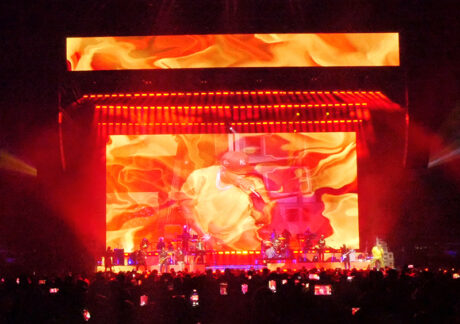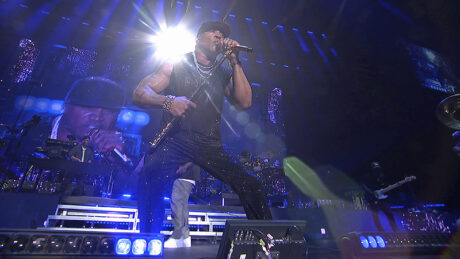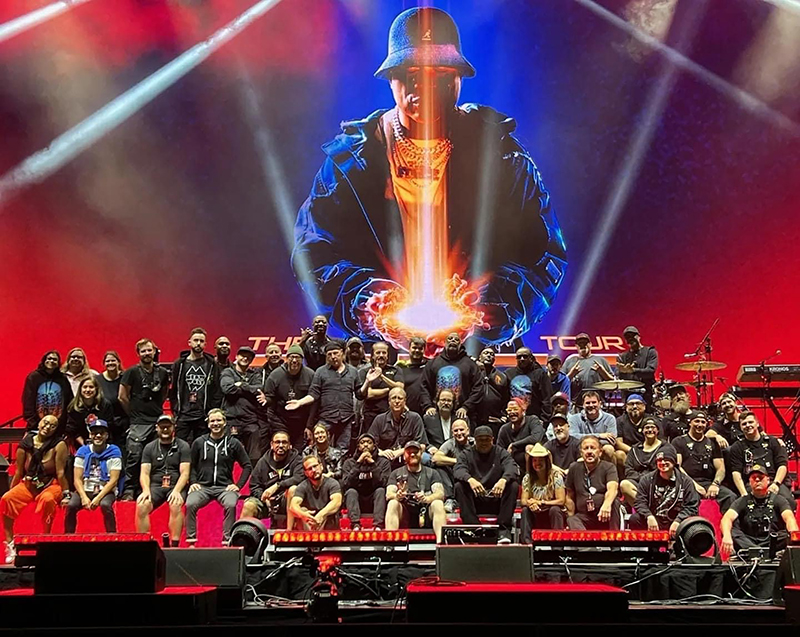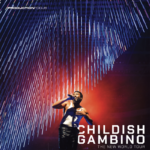
The tour was called F.O.R.C.E. (Frequencies of Real Creative Energy), with LL Cool J headlining—his first arena headlining tour in three decades. The “house band” was The Roots, and other acts along for the ride included Common, DJ Jazzy Jeff, Rakim, Bone Thugs-N-Harmony, Doug E. Fresh, Slick Rick, with additional guests showing up at every stop.
Production/Lighting Designer Gary Westcott and Video Programmer/Content Supervisor Charles Ford took a festival on the road that was filled with surprises. In every city there were different guest stars, sometimes showing up moments before they hit the stage. Set lists? Who needs set lists? Sometimes there were parts of one, but more often it was “a rough itinerary, and the local artist/special guest in each town was always a variable with audible songs being called on the fly,” Westcott says.
Many Guests, Nonstop Music
“The LL Cool J [gig] was kind of a fluke,” Westcott says. “They have asked me to help with TV performances and one-offs, and they liked what I did, so they called me for the Rock the Bell Festival.” Held in Forest Hills in Queens, Cool J first headlined the festival last year; for this year, he again hired Westcott and then decided to take the party on the road.
“It’s an interesting concept,” Westcott says. “The Roots play the entire show broken up by 15- to 30-minute segments of guest artists, with the LL Cool J set in-between.” He says they realized that it needed an “award show” design, something that worked for all these artists walking on and off. They went through a couple of different design options finding the right concept that allowed The Roots to have their space yet give the guest artists their space. And the all-LED backdrop needed to be flexible, as “sometimes we’d have eight or nine guest acts, and the next day five,” he says with a laugh. ROE Visual MC7 LED video panels were used.
“As a production designer, I put together the overall design based on what is required,” and this required quite a bit of bells and whistles including rolling stages, lifts, kabukis, and other gags. Other aspects, though, were axed due to the unavailability of trucks. “Everybody is touring now so even getting trucks and buses was tough.” But Westcott and team got creative with risers used in different configurations that made for the unique look of a stage on top of a stage look.

Three Hours Straight
Gateway Studios & Production Services (GSPS) was the vendor, which Westcott had not worked with before. He had heard of them from a conversation two years ago with Cosmo Wilson, Lighting Designer/Director for Aerosmith and AC/DC and a Director of Lighting Services at GSPS. “He was the catalyst; Gateway was able to offer us everything—lighting, video, and sound,” Westcott says. “And the decision to use Gateway was good because since it’s in St. Louis, they are centrally located, making it easy to get gear trucked, fixed, or replaced.”
For this tour, Westcott went Robe Tetras 2s. Going from a daytime festival to the dark arenas, “you want power,” which he got with 82 Tetras, which were “half as many as I originally wanted,” he adds with a laugh, acknowledging realistic budget issues.
He designed the show with a lot of key lights since there was a lot of video and video cameras mixed in with media, and he didn’t want the musicians and personalities on stage to get washed away. “I wanted the artists to be properly lit for the camera, but make sure everyone could be seen, especially The Roots, as they were truly collaborative.” His admiration for The Roots grew significantly during this tour: “They came to the arena every day at midday and went into a room where they would rehearse the acts for that night,” he says. “Then they’d get to the stage at four or five and rehearse until 7 p.m., with the downbeat of the show being at 7:30. Then they played for three plus hours straight.”
Westcott was pleased to get Ford on board, as they have worked together often over the last few years. “We had a very short turnaround and Charles is just fantastic; and it helps that we think alike,” states Westcott. He adds that a lot of the artists showed up without content, and the team needed to pull something together for them on the fly. The Green Hippo media server was used to colorize, change, and basically freshen up content, especially some of the older bits, as the show paid tribute to 50 years of Hip-Hop.

Managing Expectations
Ford has also worked with LL Cool J in the past, including previous Rock the Bell festivals with Westcott. “They usually bring me in to work their bigger screen shows and then work with all the acts integrating and bringing all the camera feeds together,” Ford says. “It’s typically managing expectations from all the different clients for that kind of festival because it is more of a TV shoot and/or throwing a bunch of people on stage.”
When it comes to the variety and surprise of it all, Ford confirms, “It’s a manual show, so it’s programmed a little bit differently than most shows.” The team had to create content that the media server could fire on the fly. “This means making sure there is a lot of flexibility with a bunch of different looks. With different acts in every city, the approach had to be completely different because there’s no way we’re going to program, you know, 300 songs from 20 different acts over the course of a two-month tour.”
Controlled Chaos
Ford appears to have the perfect attitude for the controlled chaos of it all. “It can be challenging if you’re approaching it with the wrong mindset, and I think that the wrong mindset was, ‘we know what’s gonna happen,’” he laughs. “No, we have no idea what’s going to happen. So, let’s control the things we can control, which are creating pieces that can fit.” He and Westcott huddled and came up with the idea of 20 different looks that could be flown into place like pieces of a puzzle. For example, they would have something for a slow song, and when that started, they would call the media and lighting directors and tell them what they were going for with that artist’s song. “So, there is some cohesiveness when there is no cohesiveness at all. So just kind of learning how to trick the system there.”
It’s a far cry from the typical shows he works that are structured and locked into a timecode. “But I’ve also gotten a lot of experience on the shows that just need to flow and happen without much knowledge of what’s happening.” He also worked to make the visuals manipulatable, as in “here’s how we can take live camera feeds and make that look cohesive but give it like a unique touch and feel to it.” He and his team were successful in creating cohesive looks with the unknowns and making sure all the equipment is working together.
For the video screens, the team chose to use ROE Visual MC7 LED video panel with a 7.5mm pixel pitch. The main screen measured 60’ wide x 27’-6” high, paired with the header screen that measured 60’ wide x 6’ high. The riser fascia screen was 60’ wide x 2’ high.
The server of choice was Green Hippo’s Hippotizer Boreal+ MK2. “The Mark 2 version was chosen because it’s capable of running a lot more effects, and we really needed it for its powerful processing,” comments Ford. He adds that they also wanted to make sure they were able to push the machine a little harder because “we are venturing into that world of the unknown. It’s just the best tool for what we needed.” It was used to capture the four camera feeds, and able to do multiple compositions from those feeds and throw them up on the ROE Visual video wall. A grandMA2 was triggering it all, making sure that all the looks and layers were brought up in a unified way.
Drew Best of Immanent and Lori Hamasaki supplied the content. “They gave us pieces that could take us places. For example, there was this cool desert scene that we could just fit with a particular act.” As far as artist walking in with their own content on a USB drive at the last minute… let’s just say it wasn’t encouraged. “We do have a pretty strict cut off there, but there were a few exceptions.”
Key to the success of the tour from where he sat was simply making sure they had had enough options. Otherwise, the beginning shows were a bit nerve-racking in the “what the hell is going to happen” or “what the hell are we doing” vein. “You wonder if you’re taking the right approach, but then you just go with it, trust yourself, and realize that all you can do is the best you can. It’s fun as long as you make sure that at the end of the day, you know you’re not trying to save the world, but just making the best of it.”

Vendor Support
As for GSPS, “they are great,” Ford says. “I really like their attention to detail, their gear was always in perfect shape, and their staff was just phenomenal.” Gateway’s project manager on the tour was Adam Ellis, and he says he’s proud to have gotten to work on this tour and the team Cool J assembled. “We’re just barely two years old and wanting to make an impact on the industry, and so being able to do supply a tour like this in a way that is 360 turnkey is fantastic,” Ellis states.
In a business where every tour is unusual in some ways, this one was more so according to Ellis, “We took a hip hop festival on tour where every day we had many different acts, three-plus hours of nonstop music, and no set changes. It was superb.” He adds that he was glad to be able to supply the creative team with some of the most current gear available: “We’re all 4K in all our video products, and we were especially pleased to get them some of Robe’s newest fixtures—what they were able to do with the TextraXs and Textra 2s was amazing; and Gary’s overall design with the curved trusses and linear look really popped with those lights. The way he designs lighting and video into a seamless integration is impressive.”
“We were honored to work with the entire management and production staff of LL Cool J and The Roots in bringing their vision to life for his return to touring after many years of his television series success,” added Gateway Studios & Production Services’ President of Business Development, David Haskell.
PRODUCTION TEAM
- Tour Director: Randy Buzzelli
- Production Manager, F.O.R.C.E.: Robert Schneider
- Production Manager, The Roots: Keith McPhee
- Production/Show/Lighting Designer: Gary Westcott
- Content Creation: Lori Hamasaki; Drew Best of Immanent
- Media Servers & Programing: Charles Ford
- Media Operator/Programing: Bransen Black
- Lighting Operator/Programing: Cameron Moreno
- Lighting Crew Chief: Ian Tucker
- Lighting Crew: Sam Turner, Bryan Marks, Chazz Malott, Jeff Metter
- Video Crew Chief: Gil Martin
- Video Director: Jeff Clair
- Video Engineer: Justin Dowd
- Video Crew: Eric Gerber, Josh McCormick, David Orozco, L Ptah, Jake Schimke, Jamie Jacobs
- Production Coordinators: Christina Dumey Battles, Jim Runge
- Stage Manager: Terry Cooley
- Rigger: William Humphreys
- Pyro: Sean Moore
VENDORS
- Lighting and Video: Gateway Studios & Production Services/Adam Ellis
- Staging: All Access Staging/Robert Achlimbari
GEAR
Lighting
- 4 grandMA3 full-size Console
- 34 Robe BMFL WashBeam
- 18 Robe ESPRITE LED
- 10 Robe Spiider LED
- 28 Robe MegaPointe
- 10 Robe TetraX LED
- 82 Robe Tetra 2 LED
- 18 GLP JDC1 Hybrid Strobe
- 28 CHAUVET STRIKE Array 2
- 7 CHAUVET Color STRIKE M
- 1 Robe BMFL LT FS WashBeam with RoboSpot Package
- 29 Tyler Truss GT 10’ Truss
- 30 Tyler Truss GT Gate 5°
Video
- 1 Ross Switcher Rack
- 1 Ross Engineering Rack
- 576 ROE Visual MC7 LED Video Panel
- 1 NovaStar H5 LED Processing Rack
- 4 Panasonic 4K Studio Camera
- 2 Panasonic 4K PTZ Camera
- 2 Barco UDX 4K Projector for I-Mag


